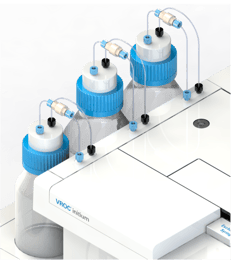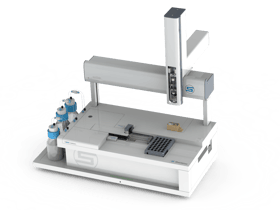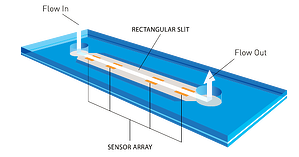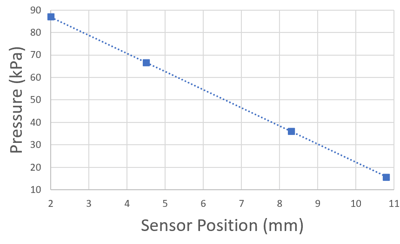The RheoSense VROC® initium one plus is the leading automated high-throughput viscometer! The VROC initium one plus includes an intuitive software that allows automatic testing of samples on 96 well plate or a 40 vial rack runs. When running viscosity measurements on the VROC initium one plus there are a few decisions that need to be made to ensure your viscometer runs optimally and that your measurements are accurate.
1. What cleaning solvents to use
When determining your cleaning solvents you should first consider the sample you are measuring. Many VROC initium one plus customers work with protein and antibody solutions, which led to the development of our most common cleaning protocol - buffer cleaning. Our buffer cleaning protocol uses a primary solvent (a good buffer proteins/ antibodies are soluble in), a secondary solvent (soap - we recommend using Aquet), and third is an enhancer, typically acetone, which is volatile and will help to ensure that the chips are completely dried out during the dryingprocess.
2. Should I use the autosampler
The VROC initium one plus autosampler feature is one major appeal of the instrument, however you are also able to run manual injection for your viscosity measurements. Loading protocols for the autosampler are adjustable, however when working with 'one off' sample measurements it can be time saving to run your high viscosity samples manually as opposed to creating new protocols. The VROC initium one plus features sample retrieval and recover, although when working with forward pass only you may want to run manual injection to guarantee a higher load in volume. 
3. What chip should I use
When it comes to measuring your samples, the channel depth of the chip you use will determine your shear rate range. The different VROC chips that pair with each instrument have different pressure ranges they can withstand and allow users to measure a range of different flow channels. There are 4 different chip types for the m-VROC and VROC initium viscometers (A, B, C, E). VROC chips need viscosity and shear rate in balance. The A05 chip is ideal for low viscosity fluids and intrinsic viscosity measurements whereas the E02 chip is ideal for high viscosity & high shear rates.
The B05 is what we consider our "universal" VROC chip. While it doesn't provide data at all temperatures or shear rates, it is our recommended starting point as it will provide data on most any sample. Learn more about selecting the right chip for your applications.  4. Sample volume requirements
4. Sample volume requirements
The minimum volume for any kind of viscosity testing on the VROC initium one plus is 26µL, however when dealing with low viscosity formulations that sample volume will limit the shear rates you are able to operate at. This will keep your measurements on the lower end of the pressure scale and therefore reduce the quality of your data.
26µL can be easily utilized for quick quality control screenings, but for lower viscosity fluids we recommend using at least 50µL of sample. Further increasing the sample volume to 90µL in each vial will allow you to use more volume per test segment, providing more data points for your transient curve.
Once you have answered the above questions it is time to prepare your samples for testing.
1. Clean Your Work Space
Having a clear and prepped work area is the first crucial step to optimizing the accuracy of your viscosity measurements. When clearing your work bench compress air is your friend! Use compressed air, canned or from a stationary compressor, to blow off your bench. This will remove lint, fibers, and dust that can contaminate your pipette or syringe when running your viscosity measurements. You should also use compressed air to bow off your 40 vial rack or 96 well plate to remove lint, fibers and dust that could contaminate your samples and data.
2. Prepare your Samples
Once your work space is prepped, it is important to prepare your sample for testing. When testing with VROC® technology we recommend following what we call the "10% Rule". Each of our flow channels has a specified depth, and we recommend when you run samples through that channel your sample particle size is less than 10% of the channel depth. For example, for an A05 chip the channel depth is 50µm, meaning that 5µm would be the maximum size for hard sphere particles in a sample run on the A05 chip. It is also important to check that your samples are well mixed for homogeneity and centrifuge if necessary. If your sample is not homogenous your data will not be reliable and you will have poor Rsq values and poor repeatability.
 Rsq is the slope of the pressure drop from the leading sensor to the last sensor in the VROC® rectangular slit microfluidic cell. There are (typically) 4 pressure sensors in each cell, and the pressure drop along the sensor array should be linear (slope = 1.000). When measuring samples, RheoSense requires a minimum Rsq of 0.997. An Rsq of 0.997 and above is confirmation that flow is laminar - all viscosity calculations, no matter what technology is used to measure and calculate, must be conducted under laminar conditions. An Rsq value below that indicates some sort of turbulence caused by something in the flow channel, such as fibers, residue or that the sample is not homogenous. A low Rsq value will result in poor repeatability which makes this an important parameter to monitor.
Rsq is the slope of the pressure drop from the leading sensor to the last sensor in the VROC® rectangular slit microfluidic cell. There are (typically) 4 pressure sensors in each cell, and the pressure drop along the sensor array should be linear (slope = 1.000). When measuring samples, RheoSense requires a minimum Rsq of 0.997. An Rsq of 0.997 and above is confirmation that flow is laminar - all viscosity calculations, no matter what technology is used to measure and calculate, must be conducted under laminar conditions. An Rsq value below that indicates some sort of turbulence caused by something in the flow channel, such as fibers, residue or that the sample is not homogenous. A low Rsq value will result in poor repeatability which makes this an important parameter to monitor.
3. Set your measurement parameters
Once you have loaded your sample into the VROC viscometer is it time to set your measurement parameters. When running samples on the VROC initium one plus you can run sample measurements on auto mode which will set your measurement to run at roughly 50% full scale at various flow rates at ~25°C. You can also customize your measurement parameters, adding flow rate and shear rates, wait time, measurement time, pause time, estimated time and volume, and customizing temperature.
Want to learn more about running viscosity measurements on the VROC initium one plus? Download the free webinar recording 'VROC® initium one plus Sample & Measurement Preparation' or contact us to schedule a FREE demo!
Written by: Eden Reid, RheoSense Senior Marketing and Sales Operations


.png?width=300&name=Sample%20Test%20(compress).png)
